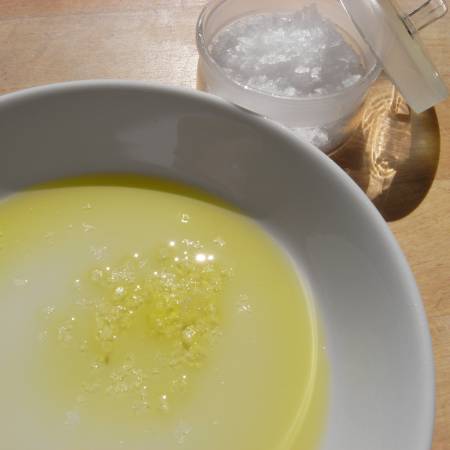
Salt in oil. According to Pierre Gagnaire, this is Hervé This’ main discovery. It allows him to sprinkle salt on dishes without the salt dissolving in water from the dish. Thereby the “crunch” of the salt is retained.
Rob Mifsud, perhaps best know for his Hungry in Hogtown blog has interviewed Hervé This. At the end of the interview Hervé lists 10 elements of basic kitchen knowledge. Some may seem obvious, but they are not, according to Hervé. Here’s the list so you can judge by yourselves:
- Salt dissolves in water.
- Salt does not dissolve in oil.
- Oil does not dissolve in water.
- Water boils at 100 °C (212 °F).
- Generally foods contain mostly water (or another fluid).
- Foods without water or fluid are tough.
- Some proteins (in eggs, meat, fish) coagulate.
- Collagen dissolves in water at temperatures higher than 55 °C (131 °F).
- Dishes are dispersed systems (combinations of gas, liquid or solid ingredients transformed by cooking).
- Some chemical processes – such as the Maillard Reaction (browning or caramelizing) – generate new flavours.

um…caramelizing is not a Maillard reaction, sorry. Caramelizing is often grouped with the Maillard reaction as examples of non-enzymatic browning, but they are separate things entirely, and give rise to completely different products. Meat browning is neither caramelizing nor Maillard reaction, but protein pyrolysis.
So next time you hear a celebrity chef go on about caramelizing the steak, or evoking the Maillard reaction, just think…………….
also, salt slows down the Maillard reaction, so don’t add salt to your steak until after its browned……
Just a question of clarification, please: Does salt actually interfere with the chemical reactions themselves (in the Maillard reaction) or does the salt draw out moisture (say, from a steak) which can drop the temperature (either by boiling off the moisture and/or by that moisture preventing the efficient transfer of heat) below the temperatures required for the Mailard reaction?
Sorry, am not trying to start a flame war, just trying to understand better this important reaction. Thanks.
Waaza: That’s correct. I just copied the list from the interview. I’m quite sure that Hervé did get this right, but that the journalist didn’t…
Regarding Maillard vs. pyrolysis – wouldn’t this depend on temperature? Say Maillard reaction up to 180 C or so and pyrolysis at higher temperatures?
Paul: This is a good question! I can’t answer you now, but I’ll try to come back to this.
The above are also basic chemistry…
Yes, salt affects reactions fundamentally. For starters, changing the ionic strength of a solution can affect the rate of reaction – this is related to how the reaction actually proceeds on a molecular level. Salt also greatly affects partitioning of compounds in heterogeneous solutions, in fact, ‘salting out’ is a traditional extraction method in chemistry. What you call “dispersed systems” I would simply call heterogeneous.
It’s also worth pointing out that water is in fact the ‘great anomaly’… virtually all other liquids boil at lower temperatures. This is due to hydrogen bonding in water, which makes it ‘thicker’ on a molecular level. Also, in a uniformly heated vessel, boiling happens uniformly. The reason you see the bubbles at the bottom of a pot is only because that’s the hottest part of the heating gradient.
Disperse system is the common name used in food science for most systems in which different phases live together (emulisons, foams, gels….). Salts affects Maillard mainly due to a reduction of water activity (between 0.65 and 0.75 is the most favourable water activity for Maillard to take place). And that’s right, I always see Maillard and caramelizing together, and most chefs say “caramelizing of meat surface”, but it’s very difficult to change this concept (the same for gelatin, which most chefs use for any kind of gel, at least in Spanish).
The list is too simple. What about taste, lipid oxidation, change of physical state, carbohidrates….
Hi Martin! More and more Spanish friends are hooked on your blog.
Martin,
Yep, it would depend on temperature, pyrolysis needing a very high temperature, but the Maillard reaction can occur at low temperatures (even in the freezer!!). And ‘ageing’ in man has feet firmly in the Maillard reaction camp (just google AGE and human body).
Paul
I don’t know why salt slows the Maillard reaction (yet), just reporting what I have read (in a scientific paper) but in the same paper they noted metals (copper and iron) speeded up the reaction rate, so frying in a non-non-stick iron pan would be beneficial from this point of view.
I think a point to make is that there is no (or lets say ‘not enough’) free carbonyl sugar present in meat to produce enough browning from the Maillard reaction alone. Next time you fry/roast chicken carcasses to make a stock, add a small amount of fructose (about the same amount as you would salt) and smell/taste the difference. Sure, some may be caramelized (though there is no sweetness detected), but most will be involved with Maillard reactions developing those flavours most associated with chicken flavour.
Very interesting comments, i found out about the true of maillard and pyrolysis not long ago and these comments cleared out some of my doubts.
Anyone know any other source for reading material about the effects of maillard and pyrolysis in meat browning? I want to finish understanding this issue.
Thanks!!
email: atram@adinet.com.uy
Few chefs are chemists. It is not surprising to me that they would lump together browning reactions, e.g. Millard reactions, caramelization, and pyrolysis. The outcomes appear similar.
I actually wrote something on browning food recently, but some of which is contradictory to some of these comments. Anyone care to provide references for what they’re saying?
Post is here: http://averagepalate.blogspot.com/2010/05/principles-and-misconceptions-behind.html